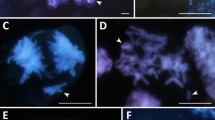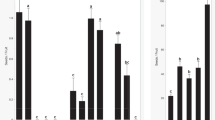Abstract
The Endosperm Balance Number (EBN) and the polar-nuclei activation (PNA) hypotheses have been developed to interpret, explain and predict interspecific and interploidy crossabilities in the Solanums and the Gramineae, respectively. Although these two hypotheses evolved independently, they share a number of common features. Assignment of EBNs and ‘activation/response values’ (AVs/RVs) depend on plumpness, size, and germinability of hybrid seeds. Also, both hypotheses emphasize the importance of a balanced parental genic contribution for the normal development of endosperm. However, in the EBN hypothesis a 2 maternal∶1 paternal EBN ratio is a prerequisite for successful interspecific crossability, while the PNA hypothesis is based on the stimulative strength of the male nuclei to initiate mitotic divisions in the primary endosperm nucleus and is idependent on a 2∶1 ratio between the RV of the polar nuclei and the AV of the male gamete. Differences and similarities betweeen the EBN and PNA hypotheses are summarized and contrasted. It is proposed that EBN and PNA be considered as the same concept.
Similar content being viewed by others

References
Arisumi T (1982) Endosperm Balance Numbers among New Guinea — Indonesian Impatiens species. J Hered 73:240–242
Bamberg JB, Hanneman RE Jr (1990) Allelism of Endosperm Balance Number (EBN) in Mexican tuber-bearing Solanum species. Theor Appl Genet 80:161–166
Boyes JW, Thompson WP (1937) The development of the endosperm and embryo in reciprocal crosses in cereals. J Genet 34:203–227
Brink RA, Cooper DC (1947) The endosperm in seed development. Bot Rev 13:423–541
Ehlenfeldt MK, Hanneman RE Jr (1984) The use of Endosperm Balance Number and 2n gametes to transfer exotic germplasm in potato. Theor Appl Genet 68:155–161
Ehlenfeldt MK, Hanneman RE Jr (1988) Genetic control of Endosperm Balance Number (EBN): three additive loci in a threshold like system. Theor Appl Genet 75:825–832
Ehlenfeldt MK, Hanneman RE Jr (1992) Endosperm dosage relationships among Lycopersicon species. Theor Appl Genet 83:367–372
Hanneman RE Jr (1983) Assignment of Endosperm Balance Numbers (EBN) to the tuber-bearing Solanum species. Am Potato J 60:809–810(abstr)
Hanneman RE Jr (1994) Assignment of Endosperm Balance Numbers to the tuber-bearing Solanums and their close non-tuber bearing relatives. Euphytica 74:19–25
Hawkes JG, Jackson MT (1992) Taxonomic and evolutionary implications of the Endosperm Balance Number hypothesis in potatoes. Theor Appl Genet 84:180–185
Johnston SA (1980) The role and nature of genic balance in endosperm development. PhD thesis, University of Wisconsin, Madison, Wis.
Johnston SA, Hanneman RE Jr (1978) Endosperm Balance Factors in some tuber-bearing Solanum species. Am Potato J 55:380 (abstr)
Johnston SA, Hanneman RE Jr (1980) Support of the Endosperm Balance Number hypothesis utilizing some tuber-bearing Solanum species. Am Potato J 57:7–13
Johnston SA, Hanneman RE Jr (1982) Manipulations of Endosperm Balance Number overcome crossing barriers between diploid Solanum species. Science 217:446–448
Johnston SA, den Nijs TPN, Peloquin SJ, Hanneman RE Jr (1980) The significance of genic balance to endosperm development in interspecific crosses. Theor Appl Genet 57:5–9
Kermicle JL (1971) Pleiotropic effects on seed development of the indeterminate gametophyte gene in maize. Am J Bot 58:1–7
Kermicle JL, Alleman M (1990) Gametic imprinting in maize in relation to the angiosperm life cycle. Development [Suppl] 9–14
Kihara H, Nishiyama I (1932) The genetics and cytology of certain cereals:III. Different compatibility in reciprocal crosses of Avena, with special reference to tetraploid hybrids between hexaploids and diploid species. Jpn J Bot 6:245–305
Kimber G, Sears ER (1987) Evolution in the genus Triticum and the origin of cultivated wheat. In: Heyne EG (ed) Wheat and wheat improvement, 2nd edn. ASA, CCSA, SSSA Pub, Madison, Wis., pp 154–164
Lin BY (1975) Parental effects on gene expression in maize endosperm development. PhD thesis, University of Wisconsin. Madison, Wis.
Lin BY (1984) Ploidy barrier to endosperm development in maize. Genetics 107:103–115
Lopes MA, Larkins BA (1993) Endosperm origin, development, and function. Plant Cell 5:1383–1399
Müntzing A (1930) Über Chromosomenvermehrung in Galeopsis — Kreuzungen und ihre phylogenetische Bedeutung. Hereditas 14:153–172
de Nettancourt D (1984) Incompatibility. In:Linskens HF, Heslop-Harrison J (eds) Encyclopedia of plant physiology: cellular interactions, vol. 17. Springer-Verlag, Berlin Heidelberg New York, pp 624–639
den Nijs TPN, Peloquin SJ (1977) The role of the endosperm in hybridization. Am Potato J 54:488–489 (abstr)
Nishiyama I (1979a) Suggestive information on an interspecific cross incompatibility system in Triticum. Wheat Inf Serv 49:32–34
Nishiyama I (1979b) An interspecific cross-incompatibility system in diploid and tetraploid Aegilops. Wheat Inf Serv 50:61–64
Nishiyama I (1981) Aegilops Triticum hybridization in view of PNA hypothesis. Wheat Inf Serv 52:39–41
Nishiyama I (1983) The mechanism of abortive hybridization in Triticinae. In: Sakamoto S (ed) Proc 6th Int Wheat Genet Symp. Maruzen, Kyoto, Japan, pp 1131–1137
Nishiyama I (1984) Interspecific cross-incompatibility system in the genus Avena. Bot Mag Tokyo 97:219–231
Nishiyama I, Inomata N (1966) Embryological studies on cross incompatibility between 2x and 4x Brassica. Jpn J Genet 41:27–42
Nishiyama I, Yabuno T (1978) Causal relationships between the polar nuclei in double fertilization and interspecific cross-incompatibility. Cytologia 43:453–466
Nishiyama I, Yabuno T (1979) Triple fusion of the primary endosperm nucleus as a cause of interspecific cross-incompatibility in Avena. Euphytica 28:57–65
Nishiyama I, Yabuno T (1983) A mechanism of the alteration of crossability in aritificial Avena polyploids. Jpn J Genet 58:51–57
Ortiz R, Ehlenfeldt MK (1992) The importance of Endosperm Balance Number in potato breeding and the evolution of tuberbearing Solanum species. Euphytica 60:105–113
Singsit C, Hanneman RE Jr (1991) Rescuing abortive inter-EBN potato hybrids through double pollination and embryo culture. Plant Cell Rep 9:475–478
Stewart JMcD (1981) In vitro fertilization and embryo rescue. Environ Exp Bot 21:301–315
Thompson WP (1930) Shrivelled endosperm in species crosses in wheat, its cytological causes and genetical effects. Genetics 15:99–113
Valentine DH (1954) Seed incompatibility. In: Proc 8th Int Bot Congr Sect 9:170–171
Wagenheim von KH (1957) Untersuchungen über den Zusammenhang zwischen Chromosomenzahl und Kreuzbarkeit bei Solanum. Arten Z Ind Abst Vererbungsl 88:21–37
Wakakuwa S (1934) Embryological studies on the different seed development in reciprocal interspecific crosses of wheat. Jpn J Bot 7:151–185
Watanabe K, Arbizu C, Schmiediche PE (1992) Potato germplasm enhancement with disomic tetraploid Solanum acaule. I. Efficiency of introgression. Genome 35:53–57
Watkins AE (1932) Hybrid sterility and incompatibility. J Genet 25:125–162
Williams EG, Maheswaran G, Hutchinson JF (1987) Embryo and ovule culture in crop inprovement. In: Janick J (ed) Plant breeding reviews, vol 5. Van Nostrand Reinhold, New York, pp 181–236
Author information
Authors and Affiliations
Additional information
Communicated by G. Wenzel
Rights and permissions
About this article
Cite this article
Katsiotis, A., Hanneman, R.E. & Forsberg, R.A. Endosperm Balance Number and the polar-nuclei activation hypotheses for endosperm development in interspecific crosses of Solanaceae and Gramineae, respectively. Theoret. Appl. Genetics 91, 848–855 (1995). https://doi.org/10.1007/BF00223891
Received:
Accepted:
Issue Date:
DOI: https://doi.org/10.1007/BF00223891



